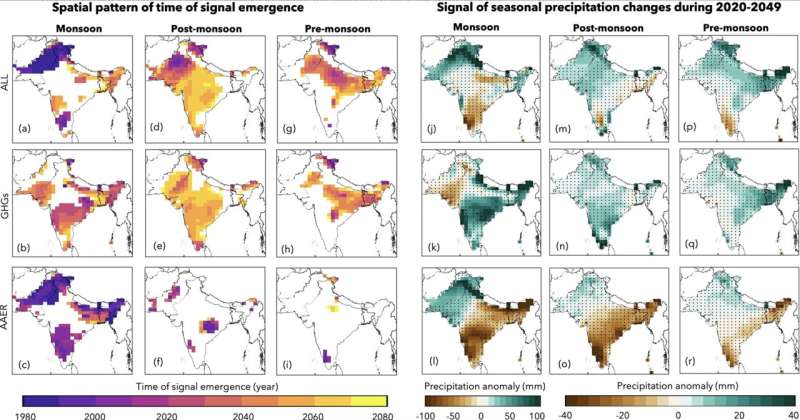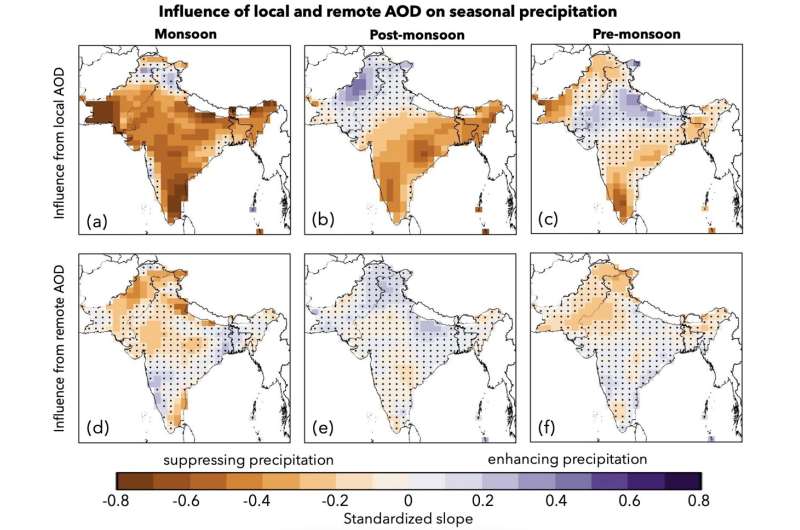October 12, 2023 feature
This article has been reviewed according to Science X's editorial process and policies. Editors have highlighted the following attributes while ensuring the content's credibility:
fact-checked
peer-reviewed publication
trusted source
proofread
Anthropogenic aerosols could delay enhanced monsoon precipitation by decades

Earth's atmosphere contains fine particles suspended in the air, known as aerosols, occurring from natural sources, such as dust from deserts, volcanic ash, smoke from forest fires, sea salt from ocean spray and organic compounds from vegetation. While these occur at background levels, aerosol release is being exacerbated by anthropogenic activities.
Human-induced aerosols have a wide range of sources, including dust and mist from agricultural practices and irrigation, pollution from megacities, aircraft emissions and even daily products like deodorants and hairsprays.
Though tiny in size, aerosols have a big impact on our planet as they scatter and absorb incoming solar radiation from the sun, while also trapping the long-wave radiation being reflected back out to space. Aerosols contribute to this further by altering cloud formation, alongside moisture and temperature gradients. Consequently, it leads to a positive feedback loop of warming the planet.
In prior decades one particular aerosol, chlorofluorocarbon, was used in personal care items such as hairsprays. These are now acknowledged to have impacted Earth's ozone layer, 15–30 km above the planet's surface in the stratosphere, protecting life from absorbing harmful ultraviolet-B radiation. Unfortunately, an "ozone hole" was created over Antarctica, though recent research has found positive news in the ozone layer over Australia seemingly repairing itself over time.
New research published in Geophysical Research Letters has further considered the impact of anthropogenic aerosols on climate patterns, particularly precipitation over South Asia where aerosol concentrations are among the highest globally.
Prior studies have confirmed a strong relationship between aerosol concentrations and monsoons, even more so than for greenhouse gases.
Dr. Jitendra Singh, of the Institute for Atmospheric and Climate Science, Zurich, and colleagues identified delayed monsoons in models up to 2050, according to the most severe greenhouse gases and aerosols emissions pathway (Representative Concentration Pathway 8.5, where the planet's temperature increases 2.6°C–4.8°C by 2100 and we are currently on course for 1.5°C warming in the 2030s). They cite that aerosols have a combative drying effect against the warming precipitation of greenhouse gases, instead suppressing this by ~30–50%.
Using the Community Earth System Model (CESM1) Large Ensemble, combining historical data with future predictions (covering 1920–2080), the research team suggest that precipitation patterns could be suppressed for up to 50 years within the monsoon season (June–September) and 10 years in the post-monsoon season (October–December).
Therefore, this is likely to have significant impacts on the economy, as well as food and water resource security, which depend upon reliable rainfall. This highlights the need for stricter policies tackling aerosol pollution, particularly as their concentration is expected to increase further still over the coming decades across South Asia.

The impact on monsoons occurs as a result of the high aerosol concentrations in the northern hemisphere pushing the Intertropical Convergence Zone (where the trade winds in the northern and southern hemispheres meet near the equator) southward and weakening this climate pattern, impacting rainfall over India in particular. Not only this, but the type of aerosol also plays a significant role, as well as their spatial distribution and cooling efficiency.
Burning of biomass and fossils dominate aerosol release in the pre-monsoon (March–May) and post-monsoon periods, while anthropogenic sources, mineral dust and sea spray proliferate in the monsoon season.
Concerning the spatial distribution of precipitation changes, the research team's modeling indicates a progressive increase, beginning in northwestern South Asia by 2049, central and southern India in the 2060s and more widely across South Asia by 2079. The offsetting effect of greenhouse gases on aerosols delays monsoon precipitation in central, southern and eastern South Asia until 2049.
Modeling aerosol optical depth (AOD), a measurement of the abundance of aerosols in the atmosphere, the research team identified an overall decline in AOD since 2020, attributing this to the powerful effect air policies in North America, Europe and East Asia may have had.
Dr. Singh and colleagues also found that local AOD levels caused a suppression of precipitation during the monsoon season, while those further afield led to a general increase in monsoon precipitation across South Asia. Overall this research suggests that by the middle of the century, monsoon precipitation patterns will change from being aerosol-driven to greenhouse gas-driven under RCP8.5 conditions.
One caveat of these findings is that they rely upon the RCP8.5 scenario, which is becoming increasingly unlikely with continued efforts to reduce carbon and greenhouse gas emissions globally. Nevertheless, it highlights the need for continued aerosol mitigation strategies and planning for uncertainty with precipitation patterns in decades to come, and how that will impact both the natural world and its human inhabitants.
More information: Jitendra Singh et al, Anthropogenic Aerosols Delay the Emergence of GHGs‐Forced Wetting of South Asian Rainy Seasons Under a Fossil‐Fuel Intensive Pathway, Geophysical Research Letters (2023). DOI: 10.1029/2023GL103949.
Journal information: Geophysical Research Letters
© 2023 Science X Network




















